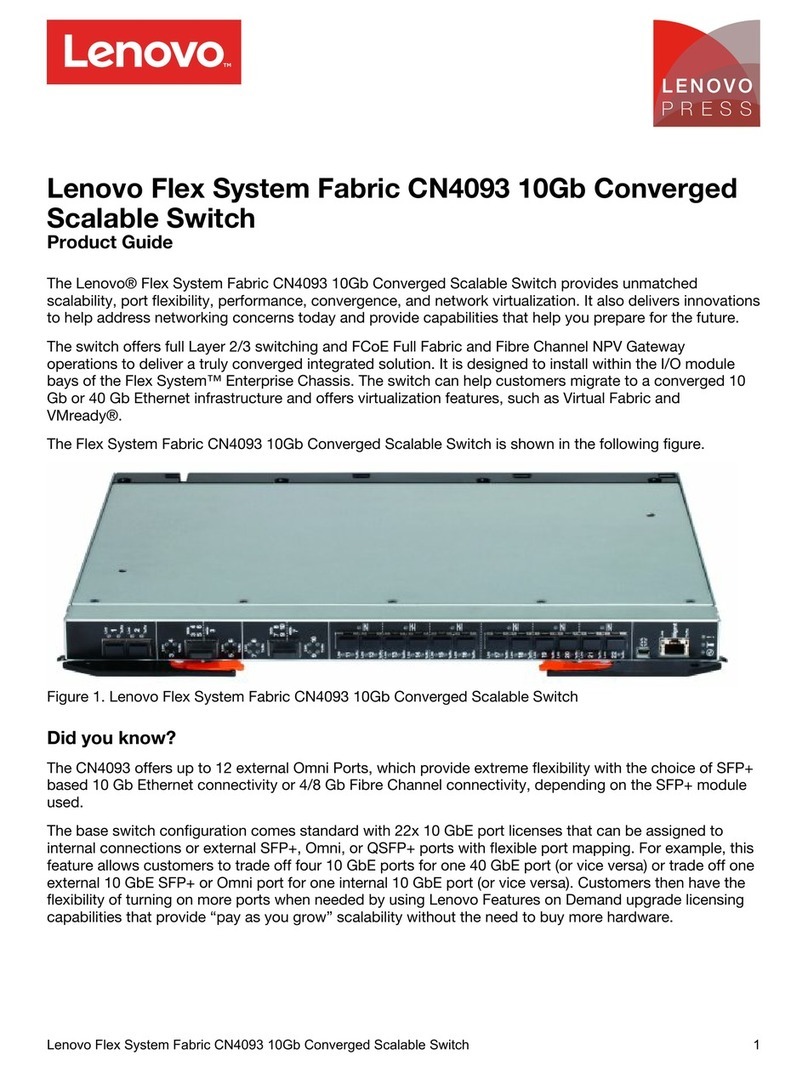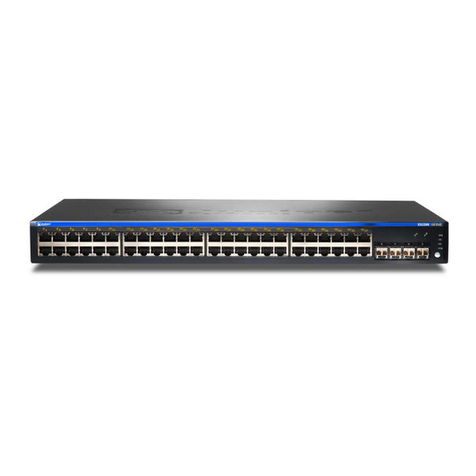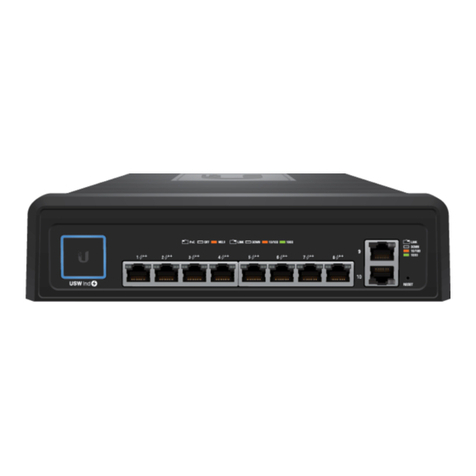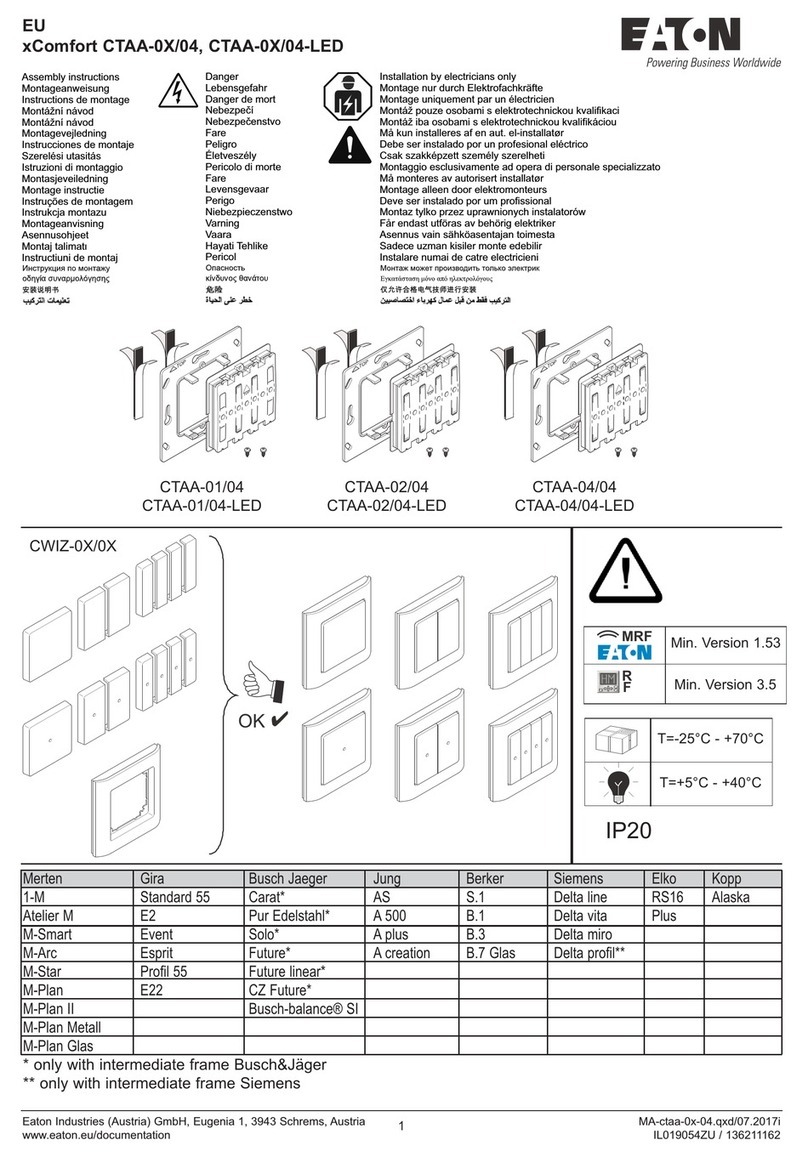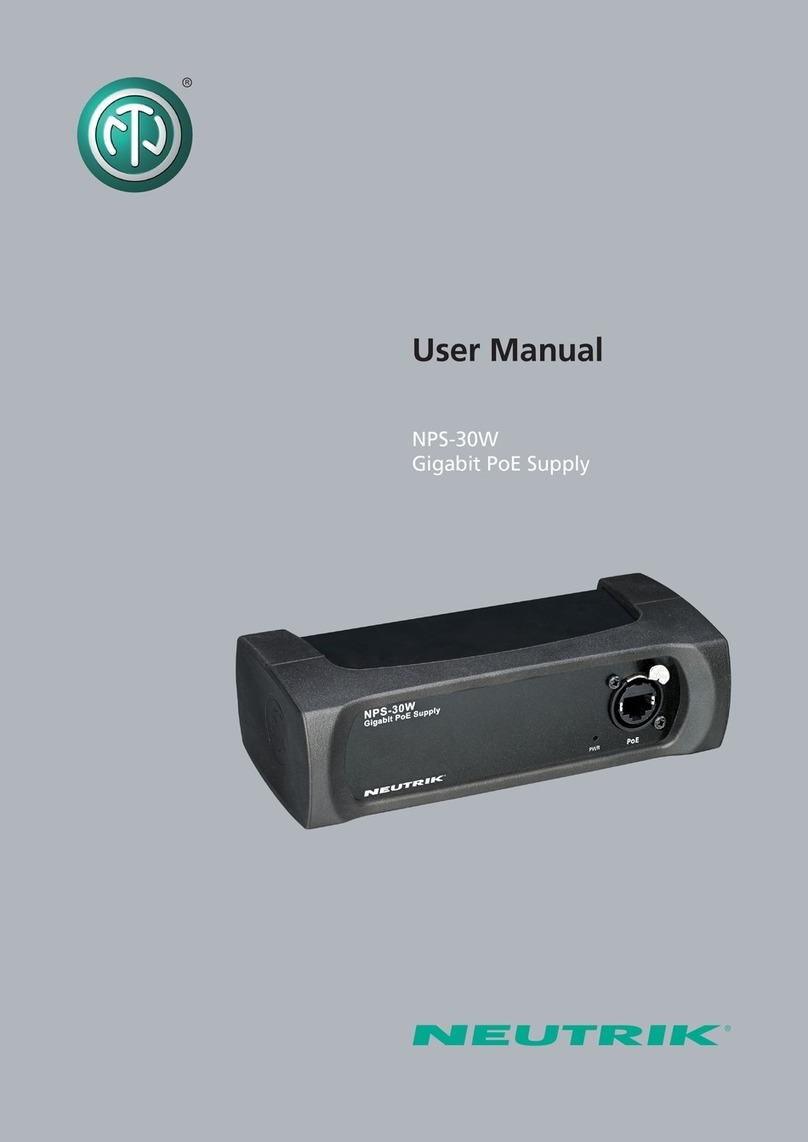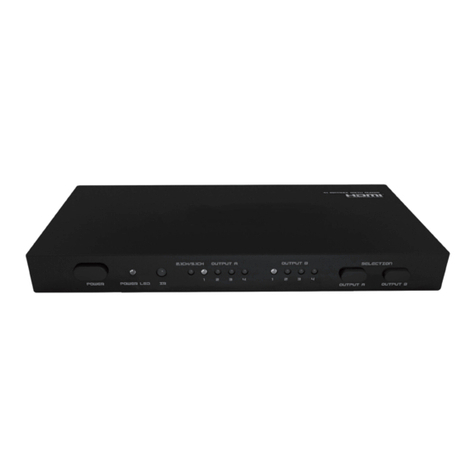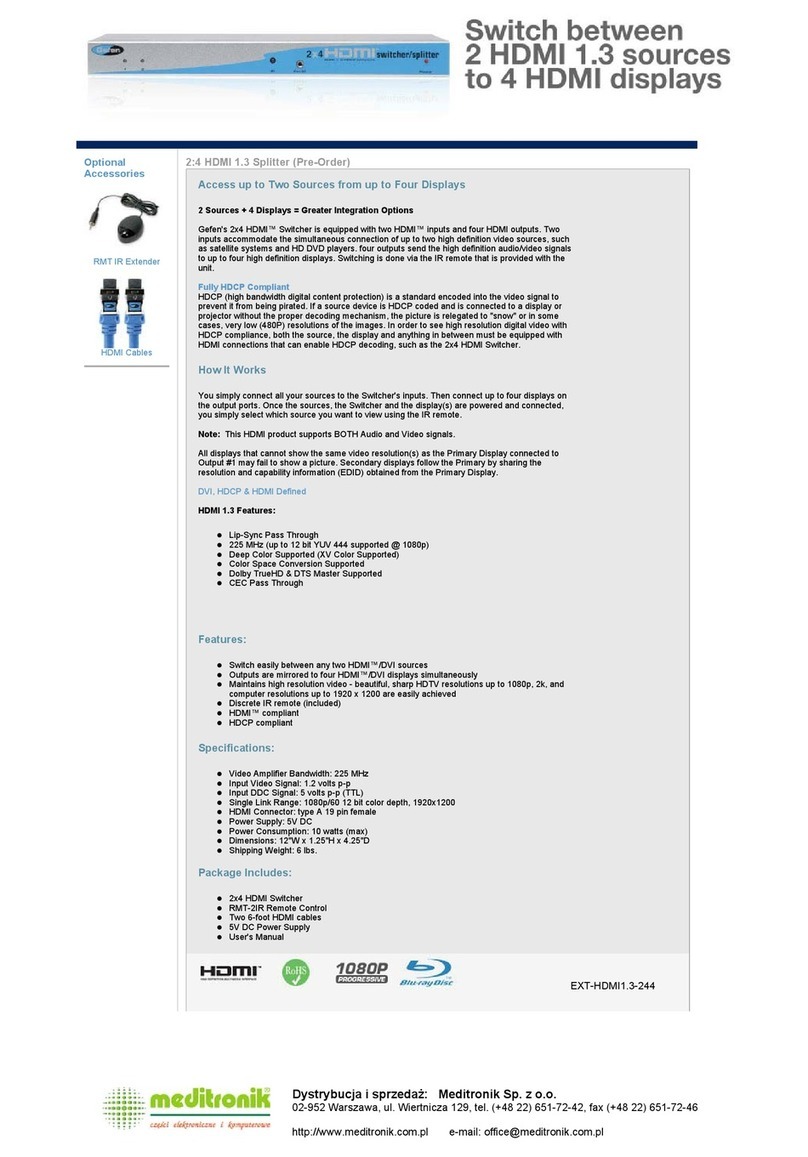SELS FT 40 R User manual

FT 40 R
SELS S.J. ul. Malawskiego, 5a 02-641Warszawa, tel.: (022) 848 08 42, 848 52 81, fax: 848 16 48
- Przestawialna głowica czujnika
-Strefa działania 200 ... 1000 mm regulowana
- Przycisk uczący
- Wyjście sygnału niepewnej strefy
działania
Parametry optyczne
strefa działania: 200 ... 1000 mm
materiałodniesienia: Kodak biały, 90 %, 200x200 mm
rodzaj światła: czerwone 660 nm, pulsed
histereza (90 %): < 15 % zakresu regulacji
norma war. optycznych: EN 60947-5-2
Parametry elektryczne
napięcie zasilania: 10 ... 30 VDC
z wew. zabezp. przed odwrotnąpolaryzacjązasil.
tętnienia: 10 %
zdalne uczenie (ET): < 2,5 V blokada/ > 10 V aktywne
pobór prądu bez obciążenia: < 35 mA at 24 V DC
funkcja wyjścia: patrz tabela
max. prąd sygnału wyjść: 200 mA z zab. krótkotrw.
częstotliwość przełączania (ti/tp 1:1): 1000 Hz
klasa bezpieczeństwa: 1)
Sygnalizacja funkcji
dioda LED zielona: praca stabilna
diodaLED żółta: stan wyjścia czujnika
Parametry mechaniczne
materiałobudowy: ABS
stopieńochrony: IP67
temperatura pracy: -20 ... +60 °C
temperatura przechowywania: -20 ... +80 °C
konektor: M12x1
masa: app. 80 g
Rys. 2 / fig. 2 / figure 2
Schemat połączeń/ wiring / Raccordement
- Tete de détection orientable
- Distance de détéction réglable200 ...1000
- Teach in apprentissage
- Sortie d'encrassement
BK:Wyjście stanu czujnika max. 200 mA
WH: Wyjście kontrolne / wyjście niepewnej strefy wykrywania czujnika max 100 mA (dla wersji FT 40 R-PSCL5 i FT 40 R-NSCL5)
WH: Wyjście stanu czujnika max. 200 mA (dla wersji FT 40 R-PAL4)
Rys 2 / fig. 1 / figure 1
Détecteur optique
réflex
dioda LED zielona /
green LED /
LED verte
dioda LED żółta/
yellow LED / LED
jaune
Przycisk / button / touche
1) Uimp = 1 kV
Czujnik odbiciowy
Optical data (typ.)
scanning range: 200 ... 1000 mm
reference material: Kodak white, 90 %, 200x200 mm
used light: red 660 nm, pulsed
histeresis (90 %): < 15 % of adjusted scanning range
ambient light: EN 60947-5-2
Electrical data (typ.)
operating voltage: 10 ... 30 VDC
internal polarity reversal prot.
residual ripple: 10 %
external teach (ET): < 2,5 V locked / > 10 V high
power consumption (no load): < 35 mA at 24 V DC
signal output: see selection table
max. output current: 200 mA with short circuit
protection
switching frequency (at ppp 1:1): 1000 Hz
protection class: 1)
Function indicators
green LED: stability indication
yellow LED: status indicator
Mechanical data
casing material: ABS
protection standard: IP67
ambient temperature range: -20 ... +60 °C
storage temperature range: -20 ... +80 °C
connection: M12x1
weight (plug): app. 80 g
- rotatable sensor head
- scanning distance 200 ... 1000 mm
adjustable
- teach in
- contamination output
Proximity switch
strefa działania (mm) 200 ... 1000 200 ... 1000 200 ... 1000
scanning diatance (mm)
Distance de détéction
schemat połączeń1 2 3
wiring diagram
Schéma de branchement
Typ FT 40 R- FT 40 R- FT 40 R-PAL4
type / order ref. PSCL5 NSCL5
type / Ref. de commande
konektor konektor M12/5pin konektor M12/5pin konektor M12/4pin
connection con. con. con.
Raccordement connecteur connecteur connecteur
funkcja wyjścia PNP NPN PNP
output (preset) N.O. N.O. N.O. i N.C.
Sortie (reglé)
Caract. optique (typ.)
Distance de détection: 200 ... 1000 mm
Matériau de référence: Kodak gris, 90 %, 200x200 mm
Type de lumière: rouge 660 nm, pulsée
Hystérésis de distance (90 %): < 15 % de distance reglé
Influence de l'eclairage ambiant: EN 60947-5-2
Caract. électriques (typ.)
Tension d'utilisation: 10 ... 30 VDC
protection contre les inversions de polarit intégré
Ondulations résiduelles: 10 %
Apprentisage externe (ET):< 2,5 V verrouillage/> 10 V haut
Consommation en courant
(sans charge): < 35 mA à 24 V DC
Sorties de commutation: voir le tableau de choix
Courant de sortie (max.): 200 mA avec protection
contre court-circuits
Fréquence de commutation (ti/tp 1:1): 1000 Hz
Protection électrique: 1)
Elementes d'indications
LED verte: indication de stabilité
LED jaune: affichage statut
Caract. mécaniques
Matériau de boîtier: ABS
Degré de protection: IP67
Température ambiante de service: -20 ... +60 °C
Plage de température de stockage: -20 ... +80 °C
Connecteur de raccordement: M12x1
Poids (Connecteur): ca. 80 g
Rys. 3 / fig. 3 / figure 3

FT 40 R
SELS S.J. ul. Malawskiego, 5a 02-641Warszawa, tel.: (022) 848 08 42, 848 52 81, fax: 848 16 48
Setup sensitivity setup
1.) Line up sensor to the object. Yellow LED and green LED are on.
2.) Press the button 3 s until both LED´s are flashing synchronously.
(The first threshold is teached).
3.) Put the object out of the scanning area.
4.) Press the button 1 s.
a:) The green LED flashes and stays on: the second threshold is
teached, the sensor is ready to operate.
b:) Both LED´s are flashing synchronously: the sensor can not detect
the object, no thresholds are teached.
Sensitivity setup only with object
1.) Line up sensor to the object. Yellow LED and green LED are on.
2.) Press the button 3 s until both LED´s are flashing synchronously.
(The first threshold is teached).
3.) Leave the object in the scanning area, press the button for 1 s. The
green LED flashes and stays on, the second treshold is teached, the
sensor is ready to operate.
Dynamic sensitivity setup at a running process
1.) Line up sensor to the object. Green LED on, yellow LED is unde-
fined.
2.) The chosen running process must be the only thing in the scanning
area! Press the button 3 s until both LED´s are flashing synchro-
nously. 3 s
3.) Press the button for a minimum of one process cycle is completed.
1 cycle
a:) The green LED flashes and stays on: both thresholds have been
teached, the sensor is ready to operate.
b:) Both LED´s are flashing synchronously: the sensor can not detect
the object, no thresholds are teached
N.O./N.C. setup
1.) Press the button for 13 s. 13 s: Both LED´s are flashing
alternately.
2.) Release the button: the green LED is on.
3.) During the green LED is on, the output is inverted by pressing the
button. If the button is not pressed during 10 s the present output
function is saved, the sensor is ready to operate.
To return to factory setting (default)
1.) No object in sensing area.
Press the button 3 s until both LED´s are flashing synchronously.
3 s
2.) No object in sensing area. Press the button 1 s.
1 s. The sensor is set to maximum sensitivity.
External Teach (ET)
10 ... 30 VDC - same function as button
0 ... 2,5 VDC - locked (disable teach button)
not connected - operating mode
Réglage de la sensibilité en statique
1.) Placez l'objet dans la zone de détection du capteur. Les 2 LEDs jaune
et verte s'allument.
2.) Appuyez environ 3 secondes sur la touche jusqu'à ce que les 2 voyants
clignotent simultanément. A cet instant, le point de commutation est
défini.
3.) Enlevez l'objet de la zone de détection
4.) Appuyez de nouveau sur la touche 1 seconde. Le réglage est terminé.
a:) Si le voyant vert est allumé, le réglage est bon et l'objet sera
détecter.
b:) Les 2 voyants clignotent simultanément après ces opérations, le
capteur ne sera pas en mesure de détecter l'objet. Le réglage n'est
pas bon, il faut renouveller les opérations 1 à 4.
Reglage de la sensibilité seulement avec un objet
1.) Placez l'objet dans la zone de détection du capteur. Les 2 LEDs
jaune et verte s'allument.
2.) Appuyez environ 3 secondes sur la touche jusqu'à ce que les 2
voyants clignotent simultanément. A cet instant, le point de
commutation est défini.
3.) Laissez l’objet dans la zone de détection. Appuyez de nouveau sur la
touche 1 seconde. Le voyant vert est allume, le reglage est terminé,
et l’objet sera détecter.
Réglage de la sensibilité dynamique
1.) Placez l'objet dans la zone de détection du capteur. Le voyant vert doit
être allumé et le voyant jaune éteint.
2.) Lorsque le process est en cours, avec passage des objets dans le
champ de détection. Appuyezsur la touche environ 3 secondes jusqu'à
ce que les 2 voyants clignotent simultanément. 3 s
3.) Appuyez de nouveau sur la touche pendant la durée total du cycle que
vous voulez détecter. 1 cycle
a:) Si le voyant vert clignote rapidement puis reste allumé, le réglage
est correct et l'objet sera détecté par le capteur.
b:) Si les 2 voyants clignotent simultanément le réglage n'est pas
correctt, il faut renouveler les opération 1 à 3.
Réglage de sortie clair ou sombre
1.) Appuyez sur la touche environ 13 secondes. 13 s
2.) Enlevez votre doigt de la touche, le voyant vert est lumineux.
3.) Pendant que la LED verte clignote chaque pression inversera la
fonction de sortie. Cela sera visible par la LED jaune. Quand la touche
n'est pas actionnée pendant 5 secondes, la fonction de sortie actuelle
reste sauvegardée. Le capteur est en service.
Retour au réglage d'origine (sensibilité maximale)
1.) Obstruez la sortie de lumière, appuyez sur la touche environ 3
secondes jusqu'à ce que les 2 LEDs clignotent simultanément.
2.) Laissez la sortie de lumière obstruée, appuyez sur la touche environ 1
seconde, le capteur est réglé à la sensibilité maximale. 1 s
Apprentisage externe (ET)
10 ... 30 VDC - même mode opératoire qu'avec la touche teach-in
0 ... 2,5 VDC - Verrouillage (touche sans fonction)
ouvert - fonction générale
Fig. 3: process diagramm handshake/ external teachin: to release teachin
process the teachwire has to be set on +UB. When the sensor has learned the
first teach-point (after about 3 sec), the control-output is set. Now the teachwire
has to be set back to 0V again. For the second teach point, the teachwire has
to be set to +UBa second time. After about 1 sec, the second teach point is
learned and the teach process is completed. This is indicated by the control-
output, which is reset when teaching is finished.
Signal of contamination output during process:
The contamination-output is activated if several unsafe signals are noticed
within a sequence of switching cycles.
Fig. 3: Diagramme du procédé Handshake / apprentissage externe : pour
déclencher le procédé d’apprentissage, il faut régler la commande à +UB.
Après que le capteur a appris la première commutation (reconnaissance –
après env. 3s) le contrôle de sortie se déclenche. Seulement à ce moment,
on peut remettre la commande à 0V. Pour la seconde commutation, il faut de
nouveau mettre la commande à +UB. Quand la seconde commutation est
apprise, le contrôle de sortie l’indique en se remettre à 0V et le procédé
d’apprentissage est clos.
Signale d’encrassement en service:
La sortie d’encrassement se déclenche quand il y a dans une sequence de
commutations plusieurs signals incertaine.
Czujnik odbiciowy Détecteur optique réflex
The factory setting for the sensor is maximum
distance. This can be changed if necessary.
Pour information, le capteur, lors de son
branchement, est réglé, à sa distance maximal. Cette
réglage doit être seulement changer aux besoins.
These Proximity Switches are not suited for safety related applications. Ces appareils de détection optique ne peuvent pas être utilisés pour des
applications de sécurité des personnes.
Proximity switch
Ustawienie fabryczne zapewnia maksymalnączułość
czujnika. W przypadku koniczności zmiany tych
ustawieńpostępuj według poniższej instrukcji:
Ustawianie czułości
1.) Przysuńobiekt do czujnika. Żółta i zielona dioda świecąsię.
2.) Naciśnij przycisk przez 3s ażobie diody zacznąmigać
jednocześnie. (Pierwszy krok uczenia zakończony).
3.) Odsuńobiekt od strefy działania.
4.) Naciśnij przycisk przez 1s (Czujnik uczy siętła).
a:) Zielona LED miga i zostaje włączona, (drugi krok uczenia
zakończony). Czujnik jest gotowy do pracy.
b:) Obie diody migająjednocześnie: Czułość czujnika nie została
prawidłowo wyregulowana. Powtórz czynności regulacji.
Ustawianie czułości tylko z obiektem
1.) Przysuńobiekt do czujnika. Żółta i zielona dioda świecąsię.
2.) Naciśnij przycisk przez 3s ażobie diody zacząmigać
jednocześnie. (Pierwszy krok uczenia zakończony).
3.) Pozostaw obiekt w strefie działania. Naciśnij przycisk przez 1s.
Zielona dioda miga i zostaje włączona, (drugi krok uczenia
zakończony). Czujnik jest gotowy do pracy.
Dynamiczne ustawianie czułości w czasie trwania procesu detekcji
1.) Przysuńobiekt do czujnika. Żółta dioda i zielona dioda świecąsię.
2.) Czujnik musi widziećjedynie badany proces! Naciśnij przycisk przez
3s ażobie diody zaczna migaćjednocześnie. 3 s
3.) Naciśnij przycisk przez czas co najmniej jednego cyklu badanego
procesu. 1 cykl
a:) Zielona dioda miga i zostaje włączona, oba kroki uczenia
sązakończone. Czujnik jest gotowy do pracy.
b:) Obie diody migająjednocześnie: Czułość czujnika nie została
prawidłowo wyregulowana. Powtórz czynności regulacji.
Zmiana funkcji wyjścia NO/NC
1.) Naciśnij przycisk przez czas co najmniej 13 s. 13 s
ażobie diody zacznąmigaćnaprzemiennie.
2.) Zwolnij przycisk: Zielona dioda świeci się.
3.) Podczas gdy dioda sięświeci wybraćfunkcjęwyjścia przez
przyciskanie przycisku.
Jeżeli przycisk jest nie naciskany przez 10s aktualna funkcja wyjścia
jest zapamiętana. Czujnik jest gotowy do pracy.
Powrót do ustawieńfabrycznych (domyślnych)
1.) Brak obiektu w strefie działania czujnika.
Naciśnij przycisk przez 3s ażobie diody zaczna migaćjednocześnie.
3 s
2.) Brak obiektu w strefie działania czujnika.Naciśnij przycisk przez 1s.
1 s. Czułość czujnika jest maksymalna (ustawienie fabryczne).
Zdalne sterownie czujnikiem przewodem wyprowadzenie ET (pin 5)
10 ... 30 VDC -funkcja przycisku włączona (dołączenie ET do pin1)
0 ... 2,5 VDC -blokada przycisku (dołączenie ET do pin 3)
brak połączenia ET -tryb pracy bez aktywacji zdalnego sterowania
Rys.3: Proces regulacji strefy działania czujnikamożnaprzeprowadzić
przyciskiem lub kablem zdalnego uczenia ET (pin 5).Przyciśnij
przycisk lub dołącz wyprowadzenia (ET) pin 5 do wyprowadzenia pin
1 (+UB). Kiedy pierwsza część regulacji (po około 3 sek.) zostanie
zakończona, wyjście kontrolne (pin 2) przechodzi w stan aktywny.
Teraz wyprowadzenia (ET) pin 5 połącz do wyprowadzenia 3 (-UB),
a następnie ponownie dołącz do pin 1 (+UB). Po ok. 1 sek.druga część
regulacji i cały proces uczenia czujnika sązakończone.
Potwierdzeniem zakończenia procesu uczenia czujnika jest
przejście stanu wyjścia kontrolnego (pin 2) ze stanu wysokiego do
niskiego.
Sygnałwyjścia kontrolnego (wyjścia niepewnej strefy działania)
podczas procesu wykrywania obiektów:
Sygnałwyjścia kontrolnego jest aktywny jeżeli pojawi siękilka
niepewnych odczytów w grupie odczytów cyklicznych.
Powyższy optyczny czujnik odbiciowy nie może byćstosowany w
aplikacjach bezpieczeństwa lub podobnych.
Controlausgang
Contamination output
Sortie d’encrassement
Externe Teachleitung (ET)
External teach (ET)
Apprentissage externe (ET)
3 sec.
1. Teach ~3sec. 2. Teach 1sec.
Handshake
Fig. 3
+U
B
0V
Wyjście kontrolne / wyjście
sygnałuniepewnejstrefy
działania
Sygnałzdalnej regulacji (ET)
pin 5
1. Uczenie 2. Uczenie
Zmiana stanu wyjścia
podczas pierwszego kroku
programowania
Popular Switch manuals by other brands
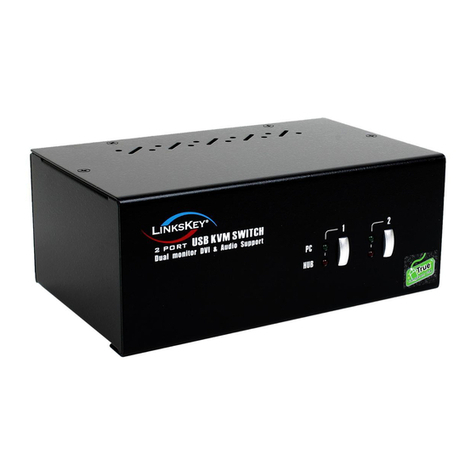
Linkskey
Linkskey LDV-DM202AU Quick installation guide

Cabletron Systems
Cabletron Systems SmartSwitch 04-0053-01 user guide

Cisco
Cisco ESW 500 Series quick start guide
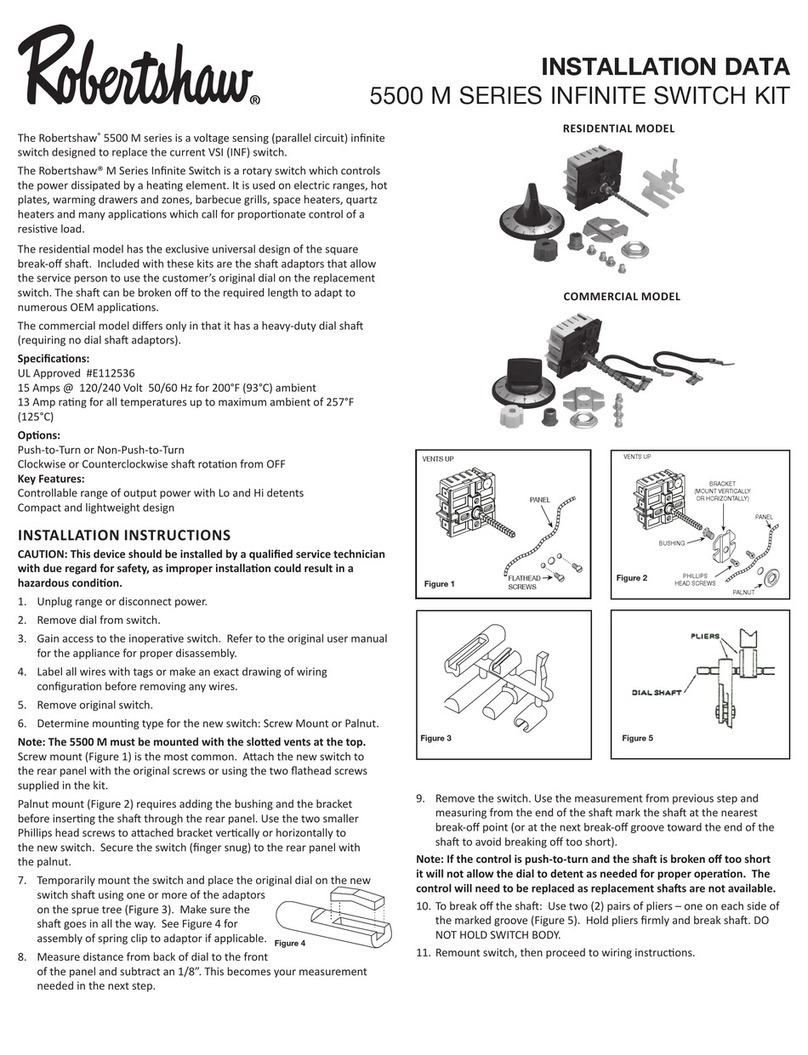
Robertshaw
Robertshaw 5500-103M Installation data
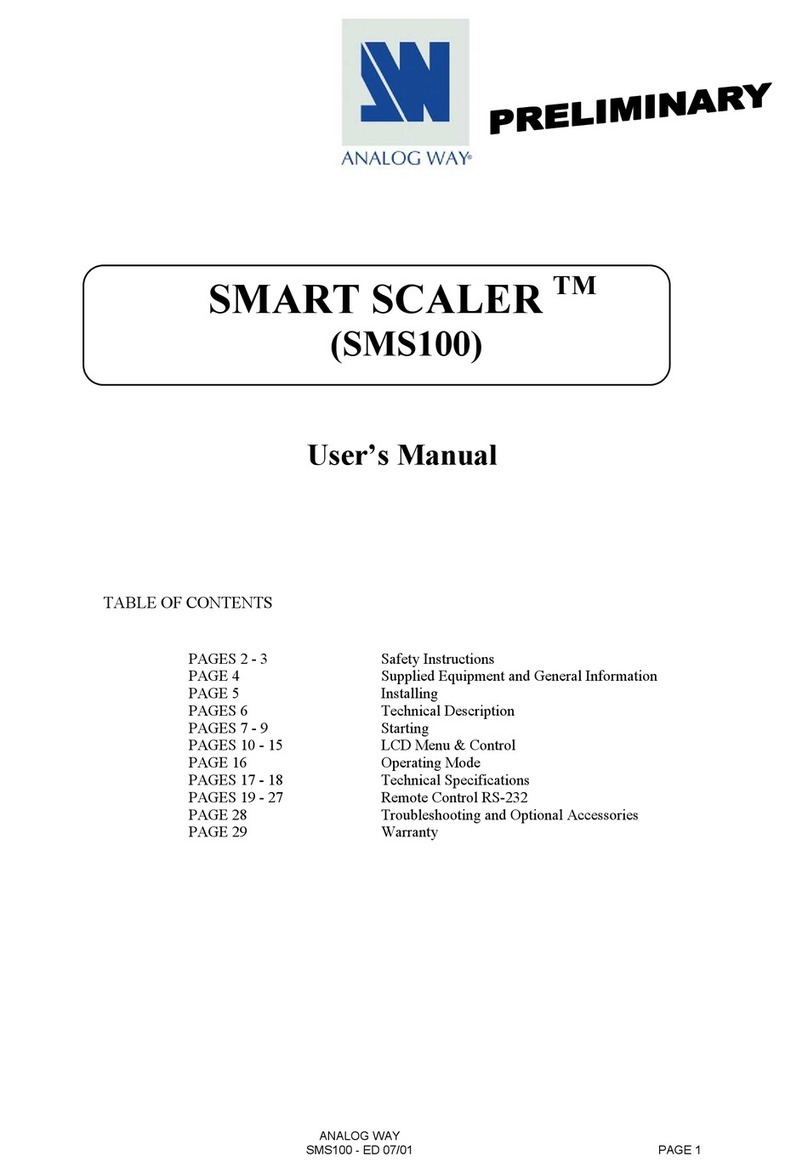
Analog way
Analog way SMS100 Smart Scaler operating manual

Rockwell Automation
Rockwell Automation Allen-Bradley Bulletin 802MC Series Installation and operating instructions
